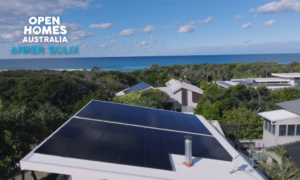Energy Matters Australia – The Solar Heat Pump Experts
Usually when you think of solar hot water, panels and a collector tank installed on a roof spring to mind – a traditional solar hot water system.
A solar heat pump is a different way to use renewable energy to heat water – that doesn’t need solar panels! Solar heat pumps can save you a bundle of cash on your hot water bills, as they use approximately one third the energy of an electric water heater.
How does a solar heat pump work?
A solar heat pump is a little like a reverse refrigerator. It transfers the heat in the air outside of the unit to the water stored inside the heater through a heat exchange system. In the case of solar heat pumps, “heat” is a relative term as they will still work in very cold conditions – at least -10 degrees celcius, so it will still be generating hot water for you during winter nights. How is that possible?
Here’s the basic process:
* External air is drawn into the solar heat pump system via a fan into an evaporator containing a special type of refrigerant, which is stored in piping. The refrigerant used is called R134a, which isn’t a CFC, so it doesn’t negatively affect the earth’s ozone layer.
* R134a has an evaporation or boiling point of -26°C; whereas water has a boiling point of 100°C. So temperatures that feel very cold to us are still more than enough to make the refrigerant “boil”. The air that’s been drawn into the system, which is far warmer than the refrigerant, turns the refrigerant from a liquid into a gas inside the solar heat pump’s piping.
* A compressor then pumps the now gaseous refrigerant through a small valve, which compresses it; and as a result of the process generates a great deal of heat.
* A heat exchanger transfers the heat from the heated refrigerant gas pipes to a tank where water is stored.
* The temperature of the refrigerant has now dropped dramatically as the heat has been drawn away, so it returns to a liquid state and the solar heat pump cycle begins again.
Benefits of a solar heat pump
* Massive savings in hot water related expenses over the long term
* A solar heat pump produces between 3 – 5 times the amount of renewable energy than electricity required to power the unit.
* It’s an environmentally friendly hot water option given the reduction in greenhouse gas emissions through less energy requirements.
* A solar heat pump is effective even in low temperatures. In extreme cold, an electric assist is activated to ensure the water stays at the desired temperature
* No roof space or panels needed
* Ease of installation as a solar heat pump uses the same connections as a electric hot water system.
How much does a solar heat pump cost?
The price varies depending upon your needs and location, but you can expect to pay up to a few thousand dollars for a good quality heat pump. However, the cost can be greatly offset as renewable energy rebates provided by many governments may apply. These rebates can be substantial, so talk to a solar heat pump specialist for the best advice on the type of equipment you’ll need and any incentives programs that might be applicable.













































